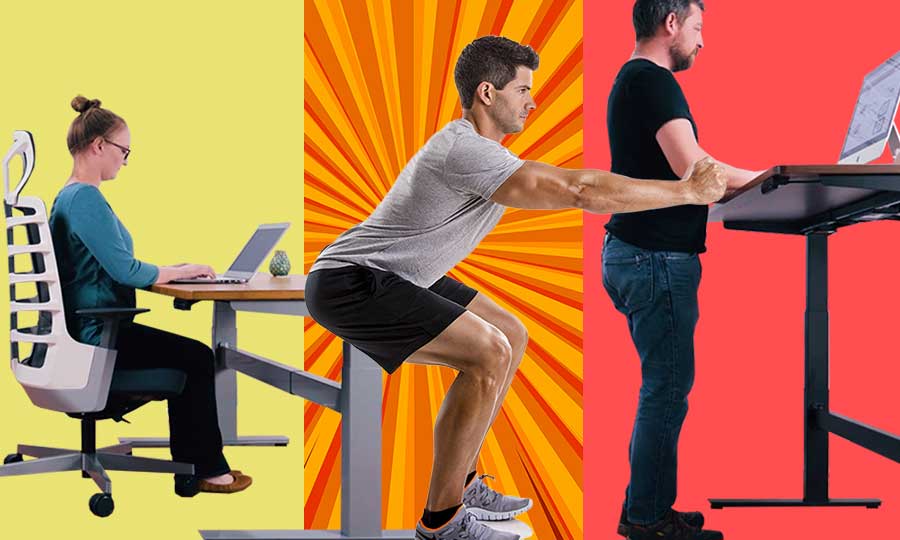The rise of mobile computing demands multi-device ergonomic support (PC and mobile). But as computing times rise, so do health-destroying sedentary behaviors. On paper, standing desks solve these issues. But many early adopters face psychological barriers that limit effective desk usage. A company called Movably(1) has identified these barriers — and solved them. This may be what sparks standing desks over the early adoption hump into the mainstream.
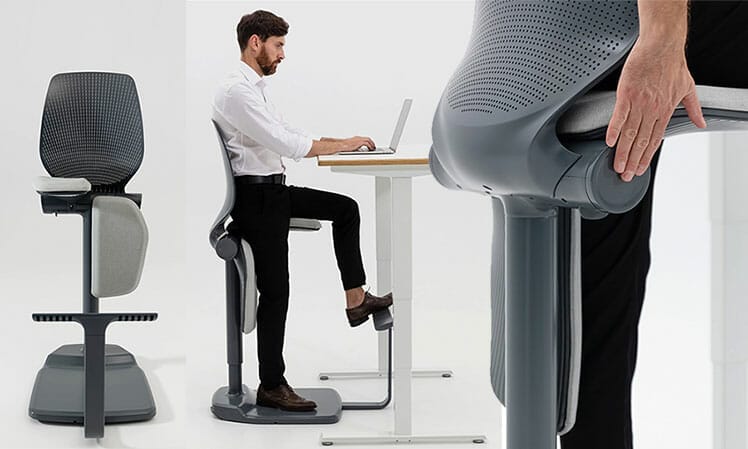
The Movably Pro Smart chair was developed by Ukrainian/American IT engineers Mark Kapij and Andriy Chulyk. Several years ago, Mark had suffered a verterbral fracture in a cycling accident. Deskwork became impossible. Ergonomic chairs didn’t help.
In 2013, ergonomist Jennifer Pynt released a paper that helped Mark understand why. None of the ergonomic chairs that supposedly promote movement actually live up to the hype(2).
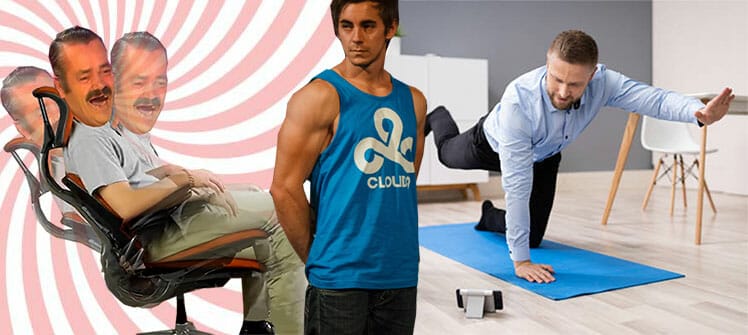
Her paper outlined unsubstantiated claims made by top office chair makers about the health benefits of their chairs. It also called for a new ‘dynamic sitting’ definition:
In 2015, Mark and Andriy founded Movably. In 2019, they began developing the Movably Smart chair. It’s currently in pre-launch as an Indiegogo startup(3).
To justify the chair’s merits, they also commissioned a study conducted at the University of Waterloo(4). The resulting paper outlines the psychological barriers that deter standing desk adoption. The Movably Pro Smart Chair is designed to solve those.
Movably Smart Chair Overview
At a glance, the Movably Pro Smart Chair looks like a cheap gimmick made for stupid people. That sounds familiar: it was the exact reaction many had in 2006 when the first gaming chair emerged. At first, they laughed…
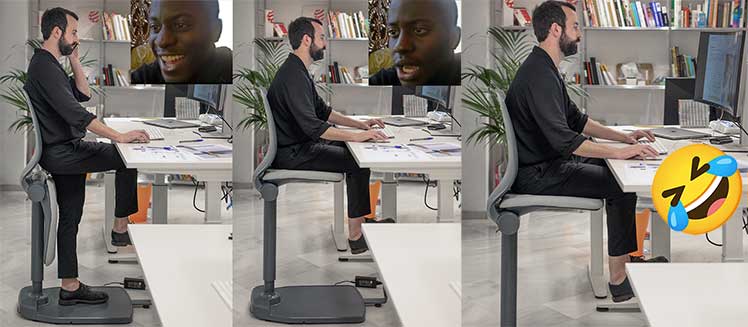
But like the early gaming chairs, there’s logic behind the unique Movably Pro aesthetics. This is a smart chair with a seat pan split into left and right sides.
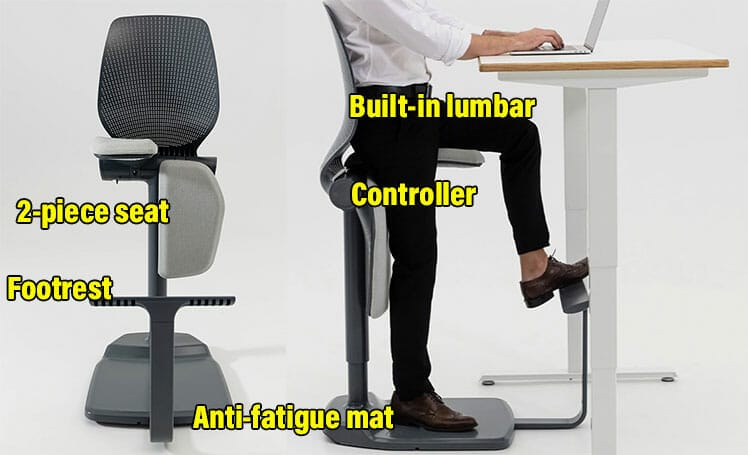
Each motorized side follows the user’s legs as they transition between sitting and standing modes. Manual inputs on either side let you toggle between modes. There’s also a pre-programmed mode that transitions at set intervals.
Movably Pro Features
This motorized smart chair has buttons on either side of the seat. A 2-second press activates auto-mode. Then, each seat half will send silent vibro-motor signals at intervals. These prompt the user to change their position.
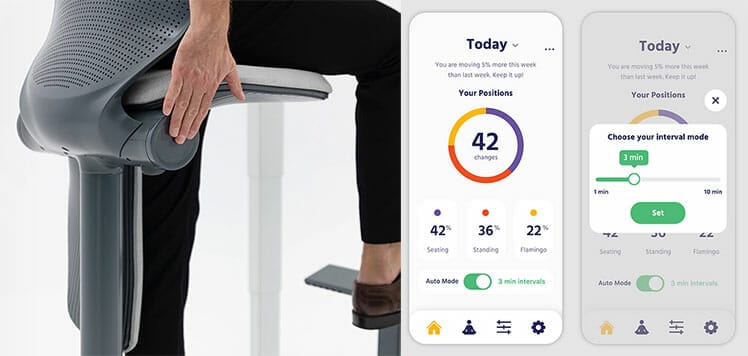
This chair works in tandem with the Movably app. That lets you customize your intervals while tracking your dynamic habits.
Summary Of Movably Pro Specs
The Movably Pro’s mechanical height and footrest adjustments position users higher than in a traditional office chair. Because of the height, you must use it with a sit-to-stand desk.
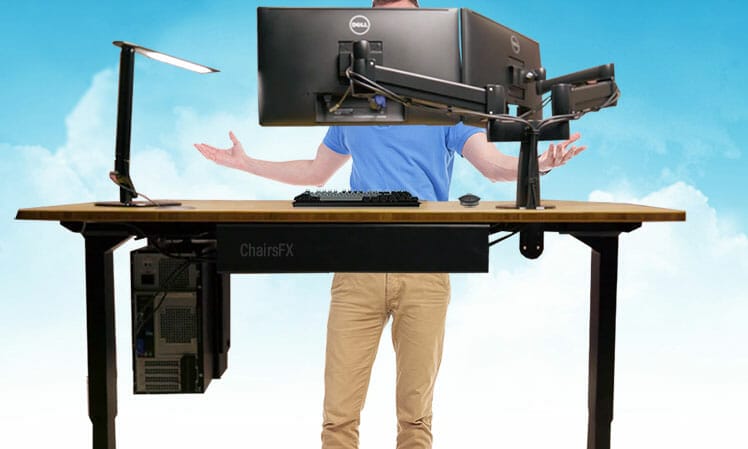
Summary of Movably Pro features:
- Seat support: flip-up half panels with motorized controls on either side.
- Seat Adjustability: height-adjustable seat and backrest (independently adjustable).
- Footrest: manually height-adjustable.
- Foot support: built-in anti-fatigue mat.
- Availability plan: small quantities available now on Indiegogo(3); crowdfunding campaign in August; early 2023 retail launch.
- Warranty: 3-year warranty; 90-day risk-free trial
Standing Desk Psychological Barriers
I use a Secretlab Magnus Pro standing desk. As soon as I got it, I started standing around 60% of the time. But at first, I could only do casual work (like web browsing) while standing.
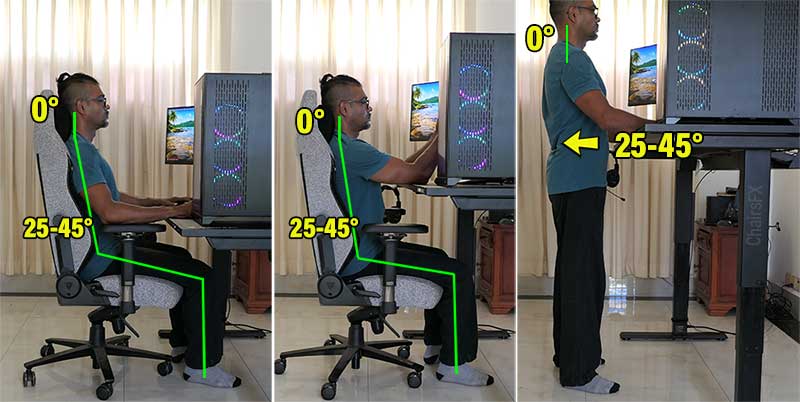
When it was time for focused work, I always sat. It took me 8 months to overcome the psychological barriers that prevent frequent sit-stand transitions.
Summary of Common Mental Barriers
Mental barriers that dissuade standing desk transitions were clarified in the Movably research paper. Highlights:
- Inconsistent use: is the most common barrier to a smooth integration into dynamic workstations(5).
- Training is necessary: a study among 4 Swedish companies found that installing sit-stand workstations without training did not alter musculoskeletal loading. Only 20% made regular sit-stand transitions(6).
- Training wears off: even with training, people struggle to maintain frequent transitions over time.
A recent qualitative evaluation study(7) highlighted two main reasons for non-use of sit-stand transitions:
- Habitual reasons: some people are so accustomed to sitting that they ‘forget’ the standing option. Many also lack the motivation to actively try to change.
- Practical issues: cable management snags can dissuade standing transitions. Also, the time needed to ‘mentally reset’ after a transition breaks focus on a task.
Movably Smart Chair Study
To verify the merits of its smart chair, Movably partially funded a standing desk movement study conducted at the University of Waterloo(4). Funding also came from the Natural Science and Engineering Research Council of Canada (NSERC).
Notably, Dr. Jack Callaghan(8) is one of the paper’s authors. His work is supported by the Canada Research Chair in Spine Biomechanics and Injury Prevention.
Abstract
A novel active office chair (Movably Pro) was designed to facilitate frequent sit-stand movement using auditory & tactile prompts with minimal-to-no work surface adjustment when transitioning.
Before the study took place, Movably agreed to let the research team publish any findings: positive or negative.
- Study purpose: compare lumbopelvic kinematics, discomfort, and task performance between the novel chair and traditional sitting/standing.
- Method: 16 participants completed three separate 2-hour sedentary exposures in the Smart Chair. Every 3 minutes, they transitioned between sitting and standing.
Results:
- Not distracting: productivity was not hindered by frequent sit-to-stand transitions.
- Healthy lumbar spine: when standing, lumbopelvic angles fell in between optimal sitting and standing targets (p<0.01).
- Pain reduction: participants suffering pain with traditional standing desks reported reduced low back and leg discomfort.
Rising Sedentary Habits Health Problems
Movably’s research paper also outlined the problem its Smart Chair endeavors to solve. In simple terms, regardless of what chair you use, sitting is bad for you.

However, standing is also problematic: 50% of the population suffers lower back pain from excess standing(5). Looming over the sit vs stand issue is that of sedentary (non-moving) behaviors.

Over the past 50 years, there’s been a steady increase in the prevalence of jobs where around 60–80% of work hours are spent in sedentary behaviors.
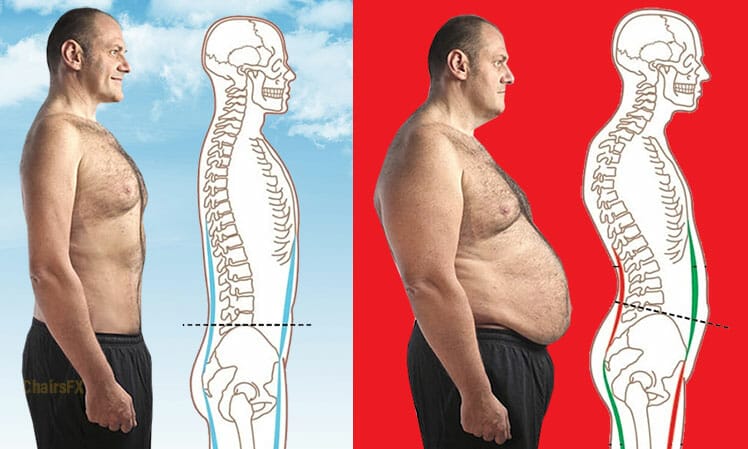
But despite the kaleidoscopic array of existing ergonomic solutions, 40-70% of the chronically sedentary develop acute lower back pain. ChairsFX has done extensive research on this subject:
Sedentary Health Problems (Compiled by ChairsFX)
Pains caused by excessive sedentary behavior include:
- Wrist disorders: 4 million Americans suffer from carpal tunnel syndrome.
- Neck pain: the 4th-leading cause of disability in America. (source)
- Shoulder pain: Americans average 4.5 million doctor visits for shoulder pain each year.
- Elbow and forearm pain: 1-3% of all Americans suffer from elbow tendonitis (tennis elbow).
Common long-term outcomes of excess sedentary behaviors include:
- Obesity: waist circumference increases by 3.1 cm with a 10% increase in sedentary time. As they add more weight, subjects become more lethargic.
- Diabetes: the prevalence of type 2 diabetes increases as sedentary time does. Regular exercise only slightly mitigates this risk. Symptoms include dry skin, excessive urination, and blurred vision.
- Hypertension: sedentary behaviors reduce blood pressure. A lower vascular resistance causes migraines, an irregular heartbeat, and fatigue.
- Cancer: prolonged sitting increases colorectal, endometrial, ovarian, and prostate cancer risks.
- Osteoporosis: sedentary behavior lowers the bone mineral density of the femur and hip sub-regions. This makes bones become brittle and easy to break.
- Depression: mentally passive sedentary behaviors (like watching TV) increase the risk of depression.
Failure Of Existing Ergonomic Solutions
None of these have yet to yield consistent lower back pain reductions in the workplace (see the Movably research paper for citation links):
- Highly adjustable office or gaming chairs designed to let users change sitting postures frequently (Antle et al., 2015; De Carvalho et al., 2016; Le and Marras, 2016; Noguchi et al., 2019).
- Administrative controls like intermittent movement breaks (Waongenngarm et al., 2021).
- Alternating between sitting and standing (Gallagher et al., 2014; Karakolis and Callaghan, 2014; McKinnon et al., 2021).
Standing Desk Ergonomic Disruption
According to market research firm Technavio, standing desks are still in the early adoption phase — on the cusp of breaking through to mainstream appeal(9).
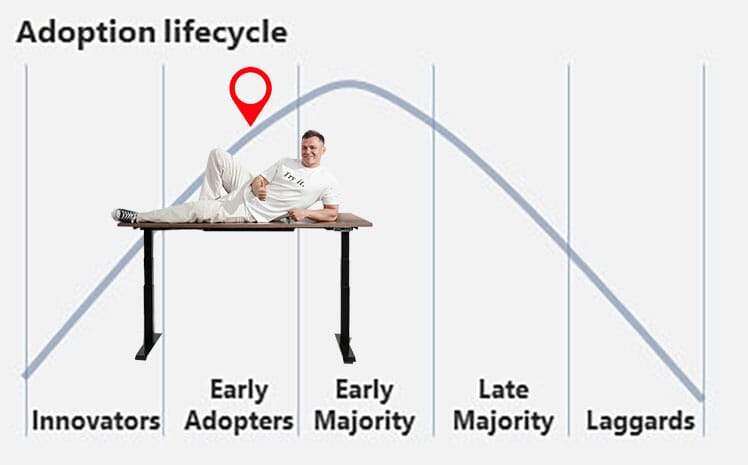
One thing preventing that: psychological barriers that prevent sit-to-stand transitions. The Movably Pro Smart chair solves those.
Multi-Device Ergonomics Is the New Priority
Ergonomic solutions for desktop computing support have peaked. From an institutional ergonomic perspective, that became ‘official’ in 2021. Then, the 5th edition Human Factors And Ergonomics Handbook (HFE) declared an ergonomic shift.
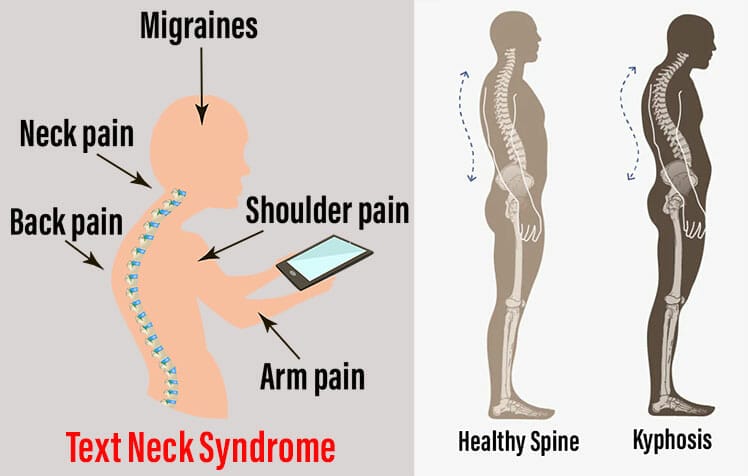
In 2023, lower back pain caused by excessive sitting is not the only ergonomic challenge. Rising mobile device usage has skyrocketed sedentary behaviors worldwide.

As a result, text neck postures that decimate upper spines are also endemic. On paper, standing desks solve both mobile support and sedentary issues.
2023 Ergo Trends: Multi-Device Neutral-ish Posture + Fitness
Standing Desk Adoption Statistics
Generic market research reports like the Technavio one(9) predict robust 5% growth in the standing desk market over the next few years. North America is expected to spearhead 37% of that growth. The ‘increasing significance of workstation aesthetics’ is the key driver of demand.
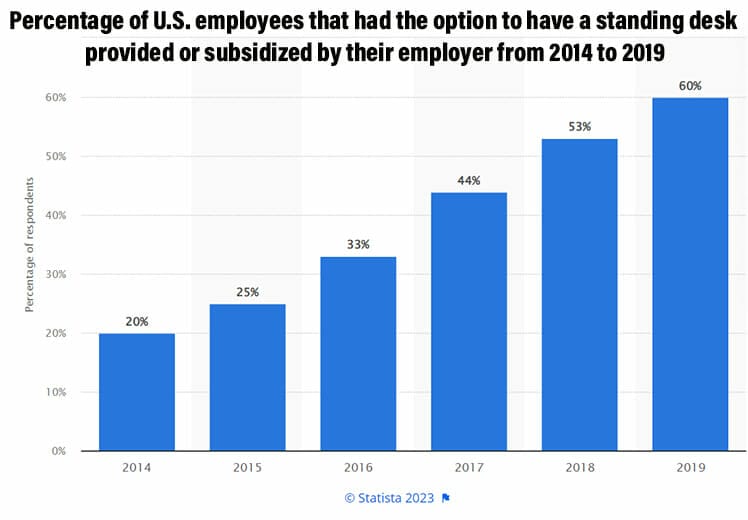
Statista supports this(10). Based on a survey, 20% of respondents indicated they would be able to get a standing desk provided by their employer. In 2019 (pre-pandemic), 60% of polled workers were given that luxury. Post-pandemic numbers are likely higher.
Steelcase Stand Up To Work Study
In 2018, Steelcase lent some sit-to-stand desks to a research study(11) called ‘Stand Up To Work’. Overview:
- Method: randomized controlled trials using Perkins & Will Atlanta employees. Workers on one floor were given Steelcase AWS (alternative work stations); participants on other floors maintained traditional desks. Questionnaires and brief real-time polling were used to track the subjects’ health and wellness behaviors.
- Measurements: polling and questionnaires measured sedentary behavior, perceived stress, and ongoing behavior changes. These were measured before installation of the AWS, and at 3, 6, and 12 months following installation.
AWS user results at timed intervals:
- 2.5 months: 17% reduction in sitting times.
- After 6 months: 15% reduction in sitting times.
- After 12 months: 88% said their AWS was convenient to use; 65% reported increased productivity; 65% reported positive health benefits beyond the workplace.
These numbers are a decent start. But according to Jack P. Callaghan, a 1-1 ratio of sitting to standing is the ideal:(5)
This brings us back to the Movably Smart Chair. A 15-17% reduction in sitting times doesn’t yield the benefits that justify the cost of a standing desk.
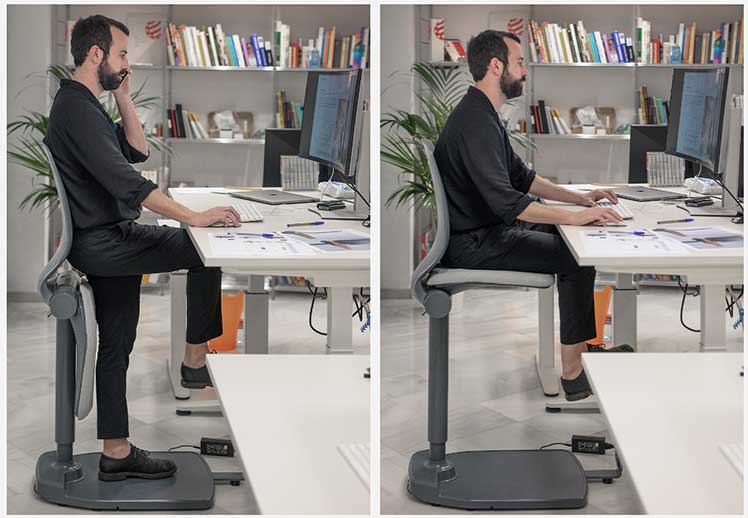
To reduce sitting times by an optimal 50%, something like the Movably Pro makes perfect sense.
Gen Z Will Drive Workstation Evolution
The work-from-home versus return to the office debate is largely settled. According to Forbes(12), if workers do not return to offices, it will impact landlords and other big city businesses:
Steelcase suggests that Gen Z (born between 1995-2012) will spearhead the return to ‘normal’. Aged 11-25 in 2023, this group will make up almost one third of the global workforce by 2025.
According to Steelcase global research(13), 25% of this generation wants to return to the office to socialize; 18% want to be in the office to access learning opportunities. By catering to this minority, the majority will follow.
What Does Generation Z Want?
Their primary wants:
- Work-life balance and learning opportunities rank highest when choosing an employer.
- Making connections and professional development are more important to Gen Z when done in the office.
- Individual office spaces will make the biggest impact for Gen Z. They want assigned workspaces that are larger and more private.
Hybrid Work Reduces Office Chair Demand
Hybrid work scenarios and the emergence of Gen Z in the workplace demands new workplace designs. Despite this, the five biggest office furniture companies all predict stagnant chair sales growth this year.

Is the seating-centric workplace era nearing its end? Two signs point in that direction:
- Seated back support technologies have peaked: there aren’t any innovations left to pursue. All top brands compete against each other with similar products.
- High office vacancy rates: office vacancy rates are now at a 20-year high. This limits the potential of ergonomic chair sales in the coming years.
But despite flagging chair sales, the top companies all show cautious optimism for new furnishing opportunities to emerge:
Standing Desk Appeal For Companies
On paper, standing desks sound perfect for these times. The novelty will delight Gen Z ages. As well, frequent transitions between sitting and standing is healthier than sitting all day.
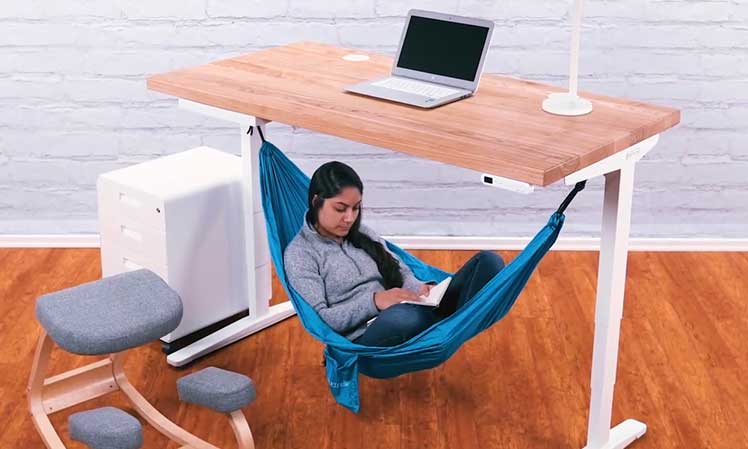
But in practice, distributing standing desks to staff is a lateral move. Based on the research, only 20% are likely to use the standing option without training. But even with training, many will regress to their old sedentary seated ways. So why bother?
Pricey Upgrades For No Gain
As is, investing in a standing desk workstation for every employee is a risky proposition. First, they’re a lot more expensive than regular ones. Second, most standing desks also need a chair.
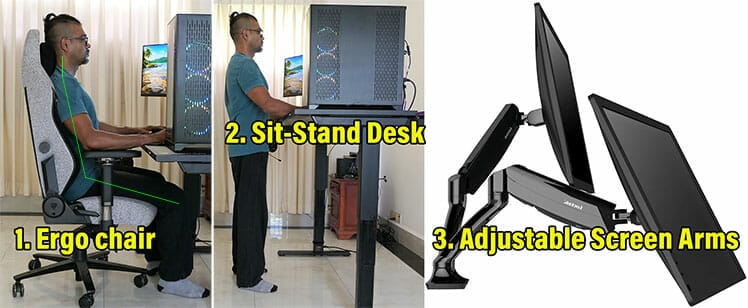
For instance, a Steelcase Gesture chair ($1400) + standing desk ($900) will cost around $2300 — not including desk accessories (like monitor arms and mousepads). But if users are not using the sit-stand functions, why bother? Unless…

The Movably Pro guarantees that users get the full benefits of their standing desk. It also negates the need for a pricey ergonomic office chair.
Office managers wanting to tart up their workplaces to delight Gen Z staffers need look no further.
Conclusion: Seating Industry Disruption
The Movably Pro Smart Chair is a major release. In fact, this might be the biggest ergonomic innovation since the gaming chair.

ChairsFX spent the past 6 years covering the seating industry-disrupting effects of the gaming chair. Back in 2006, ergonomic seating was only for rich people. Gaming chairs changed that by bringing affordable ergonomics to the masses – with pioneering B2C methods.
But in 2023, lower back problems and sedentary habits remain endemic among office workers. This is despite a plethora of $2000 office chairs on the market.
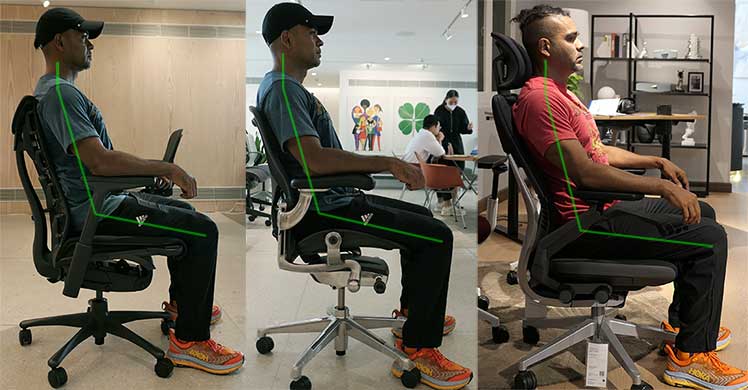
Meanwhile, hybrid work trends demand reimagined workspaces. On top of that, Generation Z will soon make up 1/3 of the global workforce. ChairsFX recently did a market analysis on Gen Z ergonomic trends. Three stand out:
- Fitness beats chair posture: 34.5 million Americans suffered chronic musculoskeletal pain (MSK) in 2018. But clinical reviews now agree with top esports doctors: exercise reduces pain & depression while boosting quality of life.
- Gen Z Proactively Addresses Pain: a 2020 survey found that 36% of Gen Z (ages 11-26 in 2023) experience back pain between the ages of 11-15. 44% addressed their pain with proactive natural solutions like stretching.
- Gen Z is passionate about fitness: 48% work out several times per week; around 1/3 of those lift weights. 60% of Gen Z ages jog vs 26% among other generations.
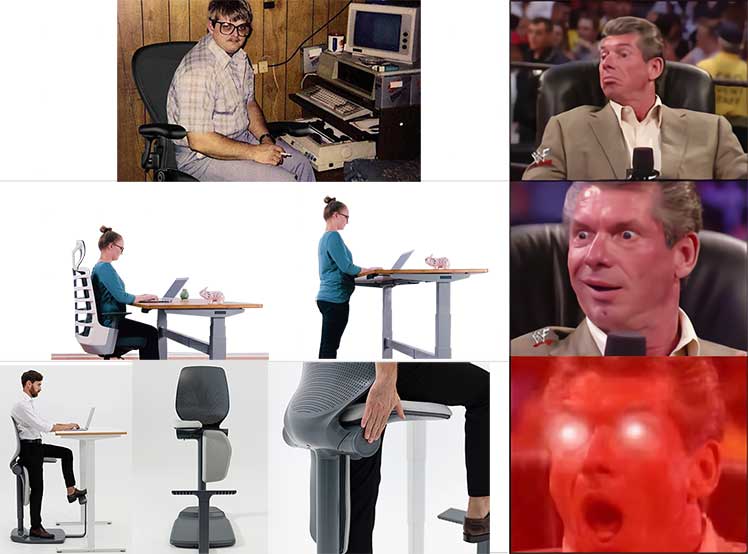
Given the facts, the Movably Pro has incredible appeal. Its physical health benefits justify the investment of a sit-to-stand desk. That fits perfectly into an office design scene looking to give Gen Z staff the workplace of their dreams.
Footnotes
- Movably.com, Smart Interactive Chair, accessed 7 June 2023, https://www.movably.com/
- Jennifer Pynt. ‘Rethinking design parameters in the search for optimal dynamic seating’, J Bodyw Mov Ther. 2015 Apr;19(2):291-303; Epub 2014 Jul 22. DOI: 10.1016/j.jbmt.2014.07.001 (accessed 7 June 2023).
- Indiegogo, ‘Movably Pro’, accessed 7 June 2023, https://www.indiegogo.com/projects/movably-pro/coming_soon
- Mamiko Noguchi, et al. ‘Increasing movement during office work at sit-stand workstations: A novel seating device to facilitate transitions’, Applied Ergonomics Volume 111, September 2023, 104044. DOI: doi.org/10.1016/j.apergo.2023.104044, (accessed 7 June 2023).
- Jack P. Callaghan, et al. ‘Sit-Stand Workstations – Are They Equal to the Hype?’ Centre of Research Expertise for the Prevention of Musculoskeletal Disorders (CRE-MSD), last updated in 2020. Read the paper (accessed 7 June 2023).
- Stephen Wilks, et al. ‘The introduction of sit–stand worktables; aspects of attitudes, compliance and satisfaction’. Applied Ergonomics Volume 37, Issue 3, May 2006, Pages 359-365. DOI: doi.org/10.1016/j.apergo.2005.06.007 (accessed 7 June 2023).
- Lidewij R Renaud, et al. ‘Natural Patterns of Sitting, Standing and Stepping During and Outside Work-Differences between Habitual Users and Non-Users of Sit-Stand Workstations’. Int J Environ Res Public Health, 2020 Jun 8;17(11):4075. DOI: 10.3390/ijerph17114075 (accessed 7 June 2023).
- University of Waterloo, Kinesiology and Health Sciences. ‘Jack P. Callaghan’. https://uwaterloo.ca/kinesiology-health-sciences/people-profiles/jack-callaghan, (accessed 7 June 2023).
- Technavio. ‘Contemporary height-adjustable desk market size to grow by USD 3.6 billion’, Dec. 12, 2022. Read the report (accessed 7 June 2023).
- Statista. ‘Percentage of U.S. employees that had the option to have a standing desk provided or subsidized by their employer from 2014 to 2019’, September 22, 2021. https://www.statista.com/statistics/742527/employer-provided-standing-desks-among-workers-united-states/ (accessed 8 June 2023).
- The American Society of Interior Designers (ASID). ‘Stand Up to Work’, May 4, 2018. https://www.asid.org/resources/resources/view/resource-center/158 (accessed 9 June 2023).
- Jack Kelly. ‘A Big Reason Cities Want Workers To Return To The Office’, April 10, 2023. https://www.forbes.com/sites/jackkelly/2023/04/10/the-real-reason-why-companies-are-desperately-pushing-for-people-to-return-to-the-office/ (accessed 9 June 2023).
- Steelcase. ‘What Gen Z Wants At Work’, June 2, 2023. https://www.steelcase.com/research/articles/what-gen-z-wants-at-work/ (accessed 9 June 2023).


